The Environmental Impact of Russian Mining in the Central African Republic

Tearline Project – 16th December 2021
Original Report
Russian Mining in the Central African Republic re causing significant environmental degradation. These mines are not directly owned by the Russian government, but are instead owned by the Russian mining company Lobaye Invest Sarlu (Lobaye Invest). Lobaye Invest is owned by subsidiaries of Yevgeny Prigozhin, a prominent Russian oligarch with direct ties to Vladimir Putin. Additionally another one of Prigozhin’s firms, the Russian private military company Wagner Group, known for its engagement in Russia’s proxy conflicts, provides security for these mines in addition to fighting alongside CAR forces in the ongoing civil war. Since the company’s registration in Bangui in 2017, Lobaye Invest has been awarded at least eight mining permits within CAR.
Lobaye Invest and Wagner Group are key entities in the deepening cooperation between CAR and Russia. At the heart of their partnership is the exchange of Russian military support and training by Wagner forces for Russian access to valuable gold and diamond deposits in CAR. This partnership began in 2017 when Lobaye Invest was first registered in Bangui. Beginning in June 2018, Lobaye Invest was granted mining recognition permits throughout the country to identify gold and diamond deposits. Since then, Lobaye Invest has discretely expanded its presence in many major cities throughout CAR. Now, at least eight mining permits have been awarded to Lobaye Invest, with most of the mines they contain being within the Lobaye and Ombella-M’Poko prefectures in western CAR.

The above-described Russia-CAR partnership has developed in the context of the Central African Republic Civil War, which has been ongoing since 2013. A crucial development in the relationship occurred in 2016 when Faustin-Archange Touadra was elected president and was quickly diplomatically courted by Moscow. After a series of initial meetings, Russian diplomats demonstrated a clear intention to gain access to CAR’s valuable natural resources in exchange for their military and diplomatic support of the Touadra administration. Such activity in CAR comes as part of a broader Russian diplomatic initiative in Africa.
Another pivotal meeting occurred in 2017, when Russian Foreign Minister Sergey Lavrov and President of the Central African Republic Faustin-Archange Touadra met and discussedcooperation in several economic sectors, including mineral exploration. Both parties agreed to strengthen their level of cooperation on diplomatic and military affairs. Since then, Russia’s military presence in CAR has been growing. Initially, Moscow appealed to the UN Security Council to bypass the arms embargo on CAR and sent combat instructors to train the Central African Republic’s Army (FACA). President Touadra then began to use Wagner mercenaries in his presidential guard and appointed Valery Zakharov – a former Russian GRU officer with direct links to Prigozhin – as his personal national security officer. Since these initial meetings, multiple large contingents of Wagner forces (officially titled “instructors” by the Kremlin) have arrived in CAR. Now, Wagner forces are openly fighting alongside the FACA, as happened in the violence following Touadra’s 2020 reelection.
After Touadra’s contentious electoral victory in December 2020, violence spiked as rebel leaders challenged the legitimacy of the elections. A united front of rebels launched an offensive on the capital city of Bangui and seized control of much of Western CAR, but were eventually stopped out by UN and FACA forces. It took the deployment of additional Russian instructors and Rwandan soldiers to aid and stabilize the situation. The FACA, working with a total of at least 300 Russian military personnel and advanced vehicles (Russian-made armored vehicles and helicopters) , reversed the rebels’ gains, retaking much of Western CAR. Coincidentally, a majority of Lobaye Invest’s mining permits are situated in these recaptured areas, and the reestablishment of government control has allowed further exploitation of these mining sites.
Mining in CAR
Mining within the Russian permit areas in CAR is primarily conducted through semi-mechanized artisanal mining practices. Artisanal mining is a labor-intensive form of mining with little to no mechanization in which manual diggers exploit alluvial mineral deposits. Semi-mechanized or semi-artisanal mining entails a combination of artisanal and mechanized practices. According to a USAID report on CAR, in 2019 there was an increase in semi-mechanized gold and diamond mining companies working on a small-scale basis.
Diamonds in CAR come only from alluvial deposits, while gold is found in both alluvial and hard rock deposits. Alluvial mining of gold and diamonds occurs through both artisanal and semi-mechanized processes. The mining sites in the Russian permit areas in CAR are almost entirely open-pit, alluvial mining sites. The major environmental impacts of these mining practices include deforestation from mining and associated infrastructure, diversion and pollution of water sources, and land degradation.
The CAR government currently has little control over the mining sector and many artisanal miners are unaware of the environmental regulations associated with mining. According to a study by IPIS, 53% of miners in CAR believe that gold and diamond resources are infinite and two-thirds of miners believe that mining has no negative impacts on the environment. There is also a significant gap between mining regulations and their implementation. A defunct Ministry of Environment and Ecology regulation provides one example of this gap; it requires a 200-meter buffer zone near streams within which vegetation must be left intact and mining is not allowed. While this rule would protect local water sources, in practice, these rules are not well known and are hardly ever enforced. Based on our findings in the following case studies, Lobaye Invest’s mining practices and failure to adhere to basic regulations are contributing to significant environmental damage to CAR.
Key Findings
These case studies are examples of trends seen across all of the Russian mines analyzed, as shown in our downloadable open database. Consistently, Lobaye Invest has demonstrated a disregard for the environmental consequences of mining. The CAR government levies little or no regulations on Russian-owned mining operations, instead focusing on the CAR-Russia military engagement, enabling mining conducted in these permit zones to ignore the potential severity of the environmental consequences. These consequences–most notably with land degradation, deforestation, and water pollution–negatively impact local communities reliant on the surrounding environment.
G1 Mine Case Study: A typical Russian-owned Mining Site
- This mining site demonstrates the typical size, structure, and components of most both open-pit dry and open-pit alluvial mining sites. Generally, Russian-owned mining sites have a negative impact on the environment causing deforestation and harm to water sources.
F13 Mine Case Study: Infrastructure
- Infrastructure development around mining sites can increase the environmental harm of a particular mining activity. This infrastructure is related to the operation of the mine, however, there is evidence of Russian military infrastructure nearby the Russian-owned mining permit areas.
F2 Mine Case Study: Mining Cluster Near a River
- Mines located within 200m of a river, like these mines, can contaminate the Lobaye River as chemical runoff from the mine decreases the pH levels of water and possibly pollutes the river with other harmful chemicals.
F4 Mine Case Study: Land Degradation
- Mines that are not properly rehabilitated after use lead to significant land degradation and leave the land unusable for other key purposes, including agriculture.
F4 Mine Case Study: Development of a Mining Cluster
- When mines are successful, operational and finding large quantities of the mineral, the sites quickly expand into clusters, regardless of environmental features near the expansion.
F6 Mine Case Study – Lobaye River Mines
- Non-rehabilitated inactive mines are found to result in high levels of toxic metal compounds in surface and groundwater resources. Further, stagnant water in these sites can lead to increased rates of communicable diseases transmitted by mosquitoes.
Methodology
The geoParsing team at William & Mary’s geoLab specializes in the merging of text and location-based data on Russian activity across multiple central African countries. The open database accompanying this article (downloadable as a CSV file) tracks activities by type, date, and location of project locations which were mappable at a high level of precision, typically more detailed than the third administrative boundary level of a country.
The eight permit areas obtained through official CAR government documentation were analyzed using satellite imagery (DigitalGlobe and public layers in Google Earth Pro) for potential mining activity. The areas within the boundaries of the permit areas were analyzed and all instances of mining activities were recorded. Each permit area was assigned a letter (A-H), and each individual mine discovered was assigned a specific alphanumeric ID composed of the appropriate permit letter and a unique number. Additionally, time-series analysis showed the progression of the mining sites where extensive damage to flora, water resources, and soil occurred.
Environmental Scorecard
Each mine was analyzed over a period of five to eight years, depending on the availability of satellite imagery. Land degradation and deforestation were coded by describing visible changes to the land color and the presence of trees and vegetation. The potential for water pollution was measured using the distance from each mining site to the nearest river. Mines within 200 meters of the nearest river were considered contributors to water pollution in accordance with regulations from the Ministry of Environment and Ecology in CAR. For every mine, each form of environmental damage was recorded as present (1) or not present (0). The water pollution category also includes a designation of 0* which signifies that a mine is near a water source, but is not within 200 meters of it. The downloadable environmental scorecard features only mines discussed as case studies. For a full list of all mines discovered in the eight Lobaye Invest permit areas, please download the open database (CSV snapshot).

Mining Case Studies
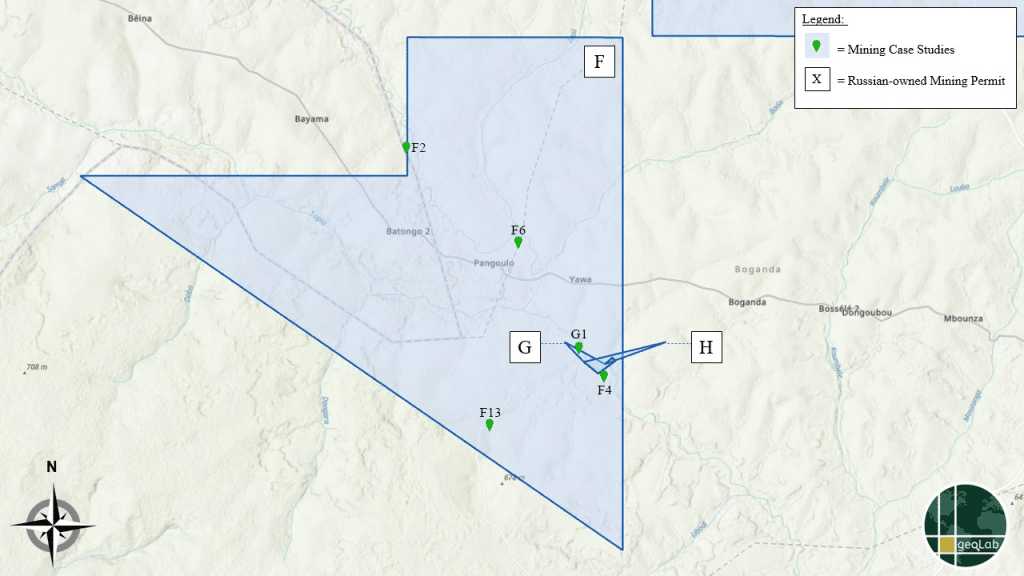
G1 Mine Case Study: A typical Russian-owned Mining Site
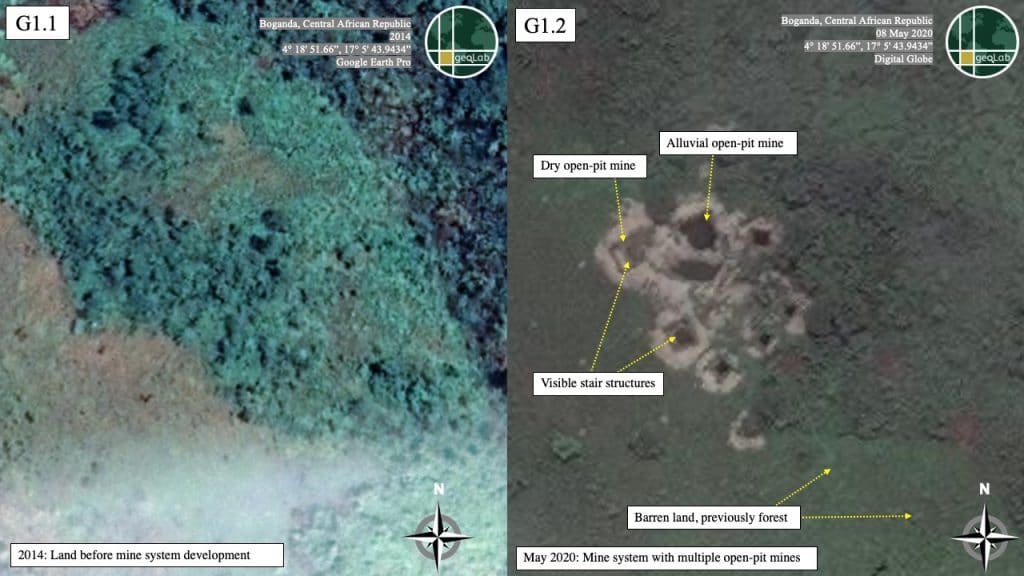
Comparative satellite images show a typical mine system’s development over time. This mine reflects the typical size, structure, and components of a mining site within a Russian-owned permit area in the Central African Republic. It features a small cluster of both open-pit dry and open-pit alluvial mines. Open-pit alluvial mines are characterized by a lighter ring of soil surrounding a pit of groundwater that emerged during the mining process. Alluvial mining involves sifting through mud, sand, or gravel in search of mineral deposits. Active mines close to river beds displace sediment in the ground, flooding the mining pit with light blue or green water. Therefore, light water in an alluvial mine indicates that the mine is active, while dark water indicates that the sediment has settled and the mine is inactive.
The impacts of many small-scale activities on local environmental conditions are generally poorly understood. One study by IPIS found that, at 78% of artisanal mining sites in Western CAR, “the color or smell of the water has changed because of exploitation of the site.” Compared to alluvial mines, dry mines feature step-like structures and no pool of water at their center. Figure G1.2 features a dry open-pit mine on the far left of the mine system. A dark square lines the interior of the open-pit mine, revealing the step-like structure that miners create to traverse deeper into the pit. On the mine farthest left in figure G1.2, a dark square lines the interior of the open-pit mine, revealing the step-like structure that miners create to traverse deeper into the pit. This mining system, close to Badea and the Lobaye River, shows the development of the mining system over five months. In January 2020, the mine system had one small open-pit alluvial mine. By February, the same pit had expanded in size. In May 2020, the mine system developed into a cluster of smaller mines that were excavated and subsequently became inactive.
Many Wagner personnel have been guarding diamond and gold mines to perpetuate government control over the Russian-owned mining permit areas. In the vicinity of these permit areas, increased damage to local water supply and forests from rebel and Russian activity has negatively impacted the population and environment, as seen in the town of Gallo. Further fighting will continue to damage the surrounding environment near the mines that will take years to recover or repair.
As seen in figures G1.1 and G1.2, this mining site has prompted deforestation of the surrounding area. As mining efforts progress and minerals are increasingly depleted, mining operations are pushed deeper into forests, resulting in increased deforestation. A study by USAID found that wholesale deforestation occurred at 98% of mining sites in Western CAR “for the purposes of extending the site (on 308 sites), heating (167 sites), or supporting mine tunnels (153 sites).” The imagery of this site clearly shows the progression of similar deforestation patterns at Russian-owned mining sites.
F13 Mine Case Study: Infrastructure
This small mine in figures F13.1 and F13.2 northeast of Bobanga shows the development of a smaller mining system and nearby infrastructure. Mining activities have direct environmental consequences, but infrastructure development can also impact the environment. To operate a mining system, mining companies must build miles of pathway, buildings adjacent to the mine, and housing for the workers. Each of these activities further degrades the surrounding land. Most mine systems within Russian-owned permit areas consist of several small pits, but the system present in figure F13.2 is one large open-pit mine in the center of a small forest. The system also features two smaller craters to the south of the largest mine. In both February and May 2020, there were several new small buildings and trucks near the mining site, indicating an increase in mining infrastructure. The satellite imagery in figure F13.1 from February also features several small buildings to the north of the mine system closer to an intricate road system. The development of infrastructure coincides with the appearance of new mines in the area, indicating that these buildings are likely tied to the operation of the mines.
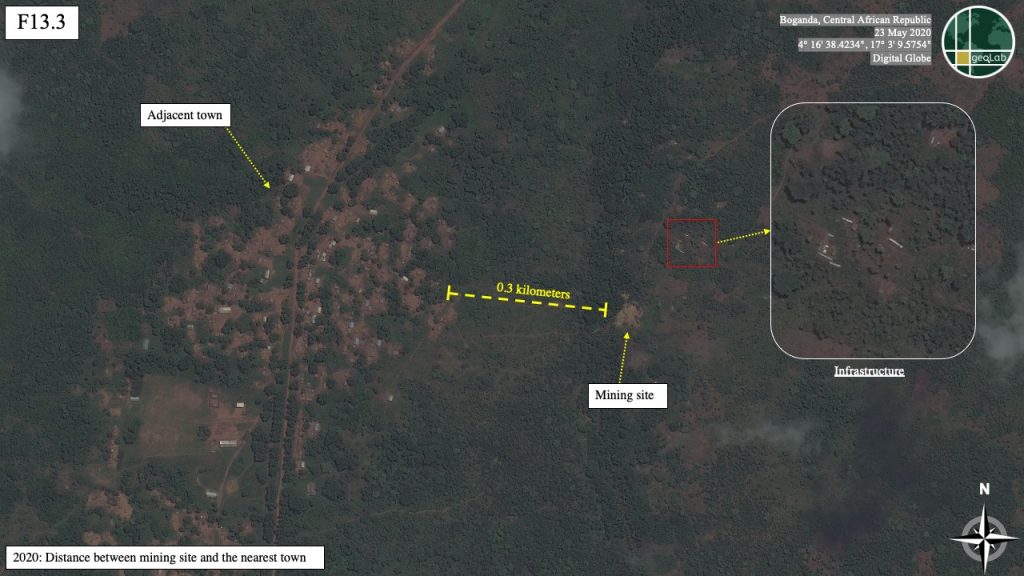
In addition to the mining-related infrastructure, the Russian contingent in CAR has also begun to build and improve military infrastructure in-country. In early 2018, Russian mercenaries established a training base at the Berengo Estate, not far from these mining areas. Russia has already demonstrated a willingness to quickly increase its presence in CAR, and further development of these mining sites could necessitate a greater Russian ground presence, which in turn could compound observed environmental degradation. The rapid development of these mining areas is tied closely to Russian military presence in CAR, as Russian mercenaries and Russian-trained forces have been instrumental in securing Lobaye Invest’s permit areas.
F2 Mine Case Study: Mining Cluster Near a River
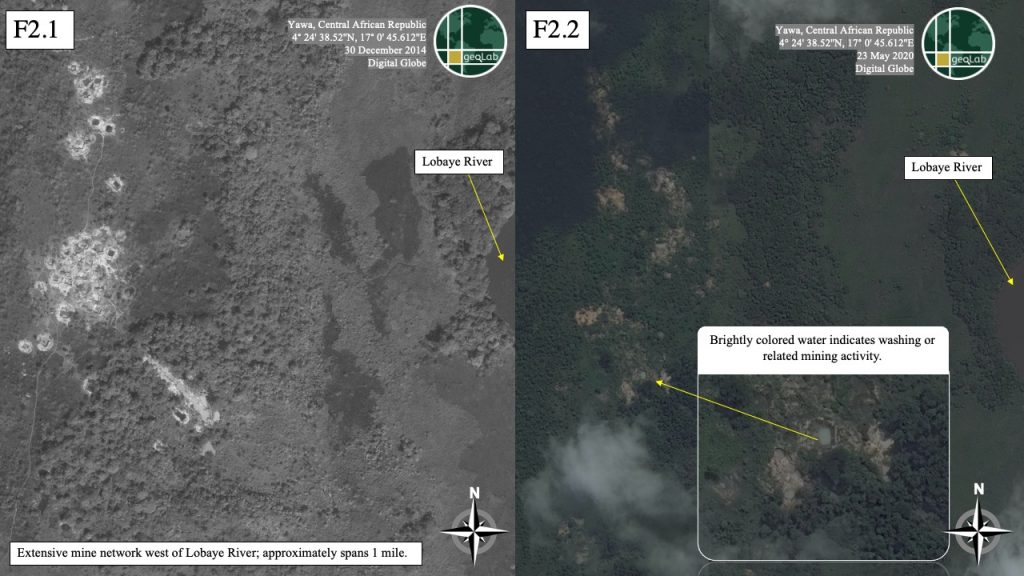
Figures F2.1 and F2.2 display a large network of mines and their development from December 2014 to May 2020. The mines are west of the town of Boda. The mine network stretches approximately a mile and runs adjacent to the Lobaye River. The varying coloration of the mines is indicative of varying levels of activity. From 2014 to 2020, there was little mining development (only some single-pit mines were added) and the vegetation grew greener and thicker. However, this difference in observed vegetation may be due to the change in season; the imagery from 2011 was taken during CAR’s dry season while the 2020 imagery was taken during the rainy season. As a result, satellite imagery of these mines does not tell us much about the level of deforestation. Open-pit mining typically releases heavy metals such as lead, copper, zinc, aluminum, mercury, marcasite, and pyrite into the local ecosystem. This contributes to a decrease in pH levels and water contamination in areas surrounding open-pit mining sites, negatively impacting agriculture, drinking water, and aquatic ecosystems. The mines at site F2 are located within 200 meters of the Lobaye River, meaning that runoff with these harmful chemicals could be leaking from the mining process and affecting nearby populations.
F4 Mine Case Study: Land Degradation
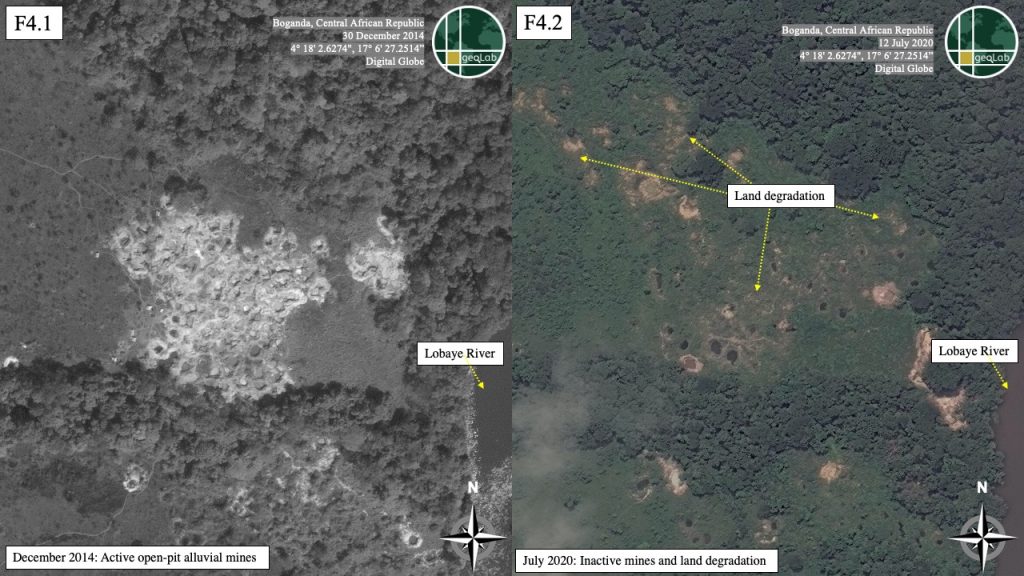
The satellite imagery above features a large mine system south of Badea and Lobaye River in Boganda, Central African Republic. A dense cluster of open-pit alluvial mines sits close (within 200 meters) to the riverbed. The satellite imagery from 2014 shows that these mines were likely active, as they are lighter in color and there is evidence of active infrastructure on the edge of the mining site. Satellite imagery from 2020 shows evidence of land degradation from the now inactive mining site. The alluvial mines are now darker in color, indicating that they are inactive. The inactive mines left patches of barren land in the area surrounding the site, and rings of barren land around each now-inactive pit. When abandoned, mining sites are replaced with dark, undisturbed water and arid land. Once mining sites have been exhausted, the excavated pits are typically left uncovered and few measures are taken to rehabilitate the area.
Rehabilitation is the process of optimizing land use post-mining and includes reclamation, which addresses soil stability and erosion, and remediation, which focuses on decontamination of mining sites. The methods of rehabilitation begin with the refill of excavated areas and uneven surfaces, removal of garbage, and disposal of hazardous waste. The next step in the rehabilitation process increases soil organic matter content by spreading manure, hay or deadwood to improve soil moisture retention and fertility. Once the soil has been rehabilitated, biological interventions are performed to revegetate the previously degraded area. Failure to rehabilitate mining sites renders the land unusable for other key purposes, such as agriculture. As seen in figure F4.2, active pit mines continue to be created as recently as July 2020, revealing a continued cycle of development and degradation in Russian-owned permit areas.
In contrast to alluvial mines, open-pit mines such as those present at mine F4 can also contribute to land degradation through physical soil disturbance, erosion, and the formation of sinkholes. The deeper the mineral deposits, the greater the scale of this degradation. Such degradation leaves land non-arable and unable to contribute to CAR’s agriculture sector, which accounts for 34% of CAR’s GDP and employs almost 70% of the workforce.
F4 Mine Case Study: Development of a Mining Cluster
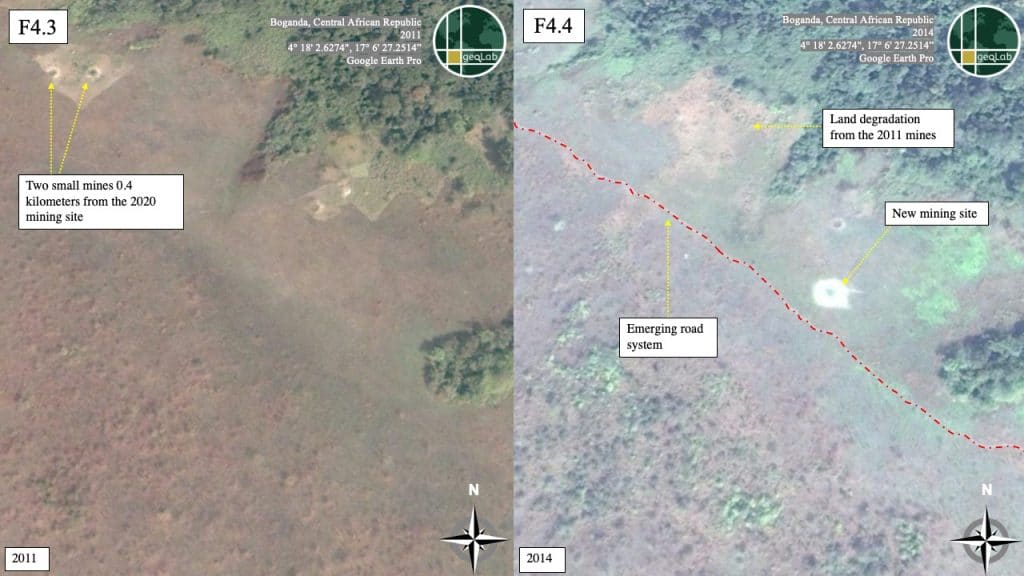
Further analysis of site F4 shows the development of a large mine system adjacent to Lobaye River both before and after the Russian acquisition of the permit area. In the 2011 satellite imagery (F4.3), two active mines are visible half a kilometer from the center of what will become a large mine system. Three years later, one active mine emerged along with an extensive road system (4.26 kilometers of pathway stretch from the mining system to the nearest main road). Land degradation, in the form of the loss of previously arable land, is visibly in figure F4.4.
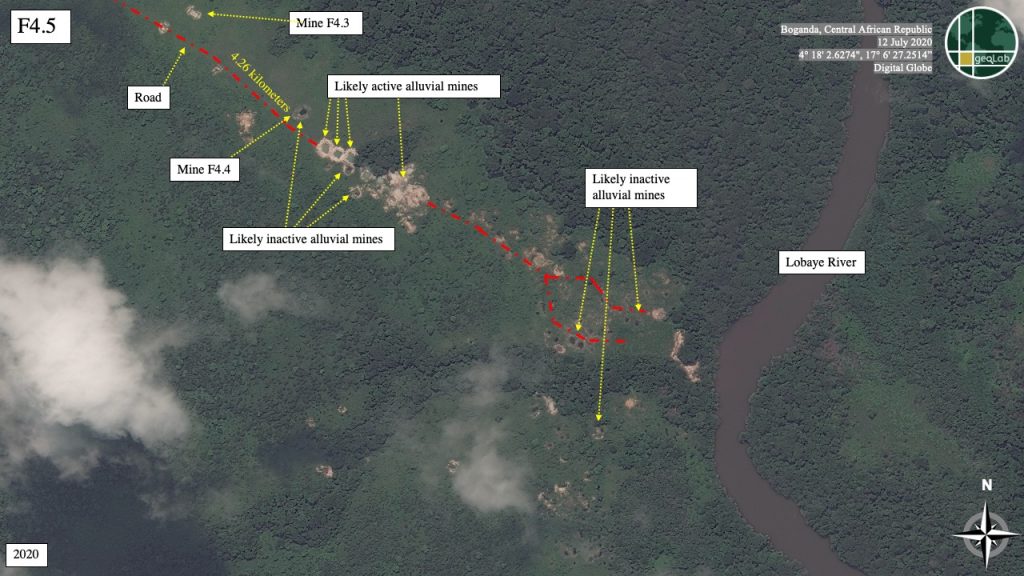
By 2020, two years after the mine was acquired by Lobaye Invest, the mine system in figure F4.5 expanded to include over one dozen open-pits that span 1.75 kilometers in length. The satellite imagery from 2020 contains both active and inactive pits in the same geographic area. The inactive system sits adjacent to Lobaye River, while the active site lies farther up the road system that leads to the neighboring city, Badea. The inactive mines are small and dense, while each mine in the active system is larger and farther from neighboring pits. This rapid expansion of the mining network by Lobaye Invest is causing severe land degradation, and the proximity of the mines to the river ensures that significant water pollution will take place. Russia’s lack of commitment to reversing land degradation further emphasizes that its focus is on rapid economic development and gain. Prior to 2014, Russia had not officially received permit grants to the mining areas and the mines were rather underdeveloped. Following the signing of the permits granting mining access to Russia, in the period between 2014 and 2020, rapid development of mines and the surrounding territory occurred.
F6 Mine Case Study – Lobaye River Mines
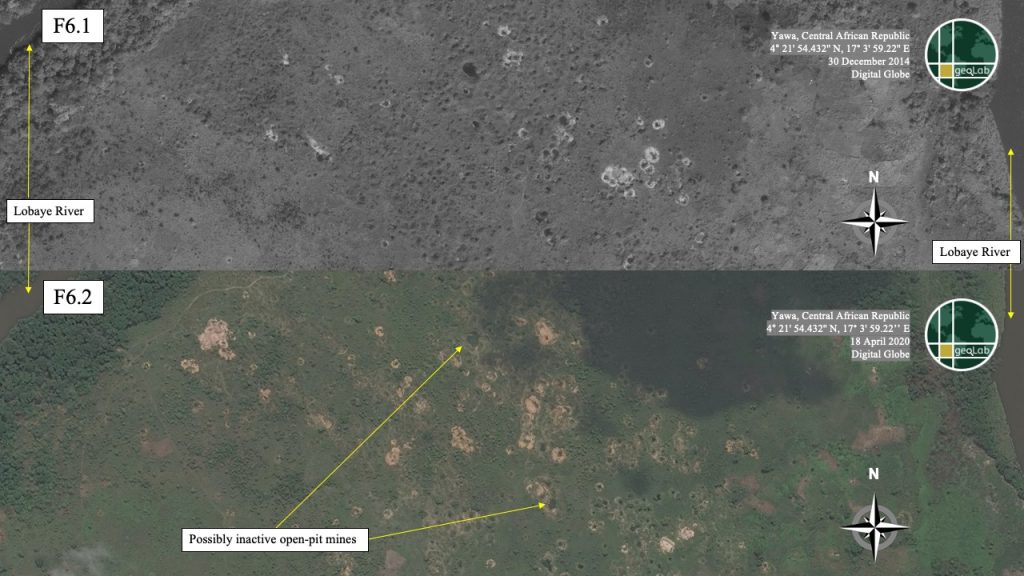
Figures F6.1 and F6.2 show mining development directly adjacent to the Lobaye River and near the town of Yawa. The color of mine pits is indicative that this mine network is plausibly inactive. However, certain pits possibly have blue water in them, indicating some recent mining activity. From 2014 to 2020, there has been substantial development of the mines. In 2014, there were only a handful of pits, however by 2020, there were numerous pits spanning the area below the river. Since the surrounding area is an open field, there was already minimal vegetation at this location. The development of this mining site seems to have had little to no impact on the existing vegetation.
Assuming that the majority of the mines at this site are now inactive, figure F6.2 provides further evidence of a lack of rehabilitation efforts post-mining. Furthermore, the lack of Russian commitment to land rehabilitation suggests a disregard for the environmental impact. Russian endeavors appear to be more economically driven than balanced with environmental measures. Failure to refill inactive mines can lead to increased rates of communicable diseases transmitted by mosquitoes such as Dengue Hemorrhagic Fever and Malaria. When alluvial mines are not rehabilitated and refilled after use, they create areas of stagnant water that are prime breeding grounds for mosquitoes. Studies throughout Latin America have linked abandoned mines with increased cases of malaria among mine in workers and in surrounding areas. It is likely that these abandoned mines in CAR, a country that already struggles with malaria, would have a similar effect. Lack of rehabilitation also means that any harmful substances used during the mining process further damage the local environment.
In 2014, UNESCO conducted a survey of abandoned mines in Sub-Saharan Africa to determine their environmental impacts. The results showed that mining activities resulted in high levels of toxic metal compounds in surface and groundwater resources as well as surrounding soil and vegetation. Chemicals such as mercury and cyanide are used in small-scale gold extraction and pollute surrounding water and land. Wastewater is also created as a part of the alluvial mining process, polluting rivers. Given its proximity to Lobaye River, this mine site likely contaminates the water, harming both the aquatic and terrestrial ecosystems. Mining near water sources also contributes to erosion, which increases siltation and sedimentation in rivers, resulting in reduced fish populations. While the negative effects of chemicals released through these mining practices near the Lobaye River are difficult to quantify, we assess from the general literature of negative impacts that this is occurring in this case and others around the Lobaye River.
Conclusion
Russian mining activity is negatively impacting the environment in the Central African Republic. While cooperation between Moscow and Bangui is nominally based on military and economic engagement, the environmental impacts of Lobaye Invest’s fledgling mining operations are a noteworthy byproduct. Satellite imagery has provided critical insights into how these mines are impacting the environment in CAR. The primary ways that mining has observably damaged the environment are land degradation, deforestation, and water pollution.
Since Russian-owned mining operations face little or no regulations, the mining conducted in these permit zones has not been accompanied by efforts to address their environmental impacts, despite their severity. As seen in all five case studies, land degradation is widespread and largely unaddressed throughout Russian-owned permit areas. A failure to properly address continued land degradation could ultimately render large swaths of inactive mining plots unusable in the future and potentially increase the spread of endemic diseases such as Malaria. Rapid deforestation has been observed in case studies G1, F13, and F2, with the effects of deforestation increasing in the years since Lobaye Invest acquired ownership of the sites. Case studies F6 and F2 demonstrate a general disregard for safeguards regarding water pollution, as reckless mining operations continue to expand dangerously close to the Lobaye River. Continued neglect of key environmental safeguards could lead to continued toxic pollution of a key water source.
While the issues of land degradation, deforestation, and water pollution are prevalent in CAR, they are also present throughout the sub-Saharan region. If the Russian model of engagement both politically and economically with CAR proves successful, continued Russian outreach will lead to similar mining projects. Such an expansion of mining projects elsewhere could also be accompanied by a lack of environmental regulations, resulting in similar. negative environmental effects throughout the central African region.








